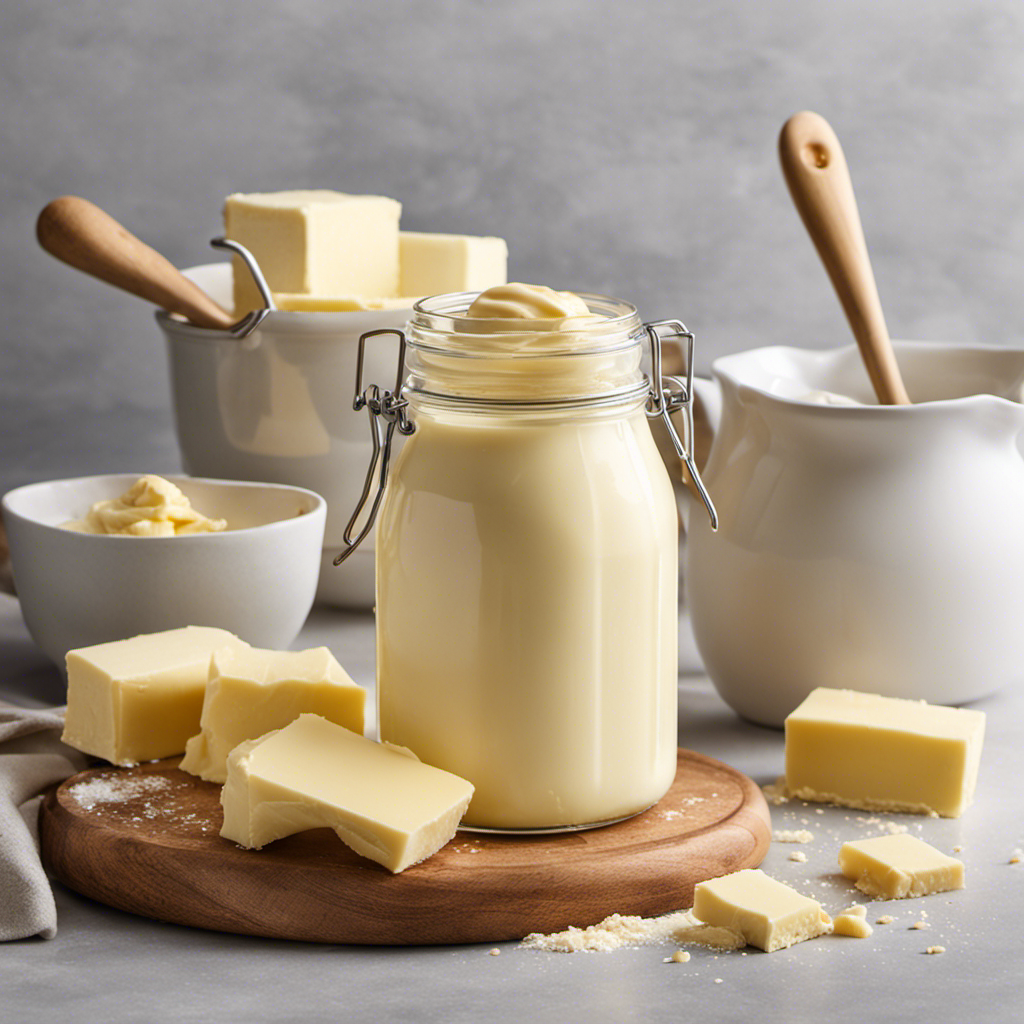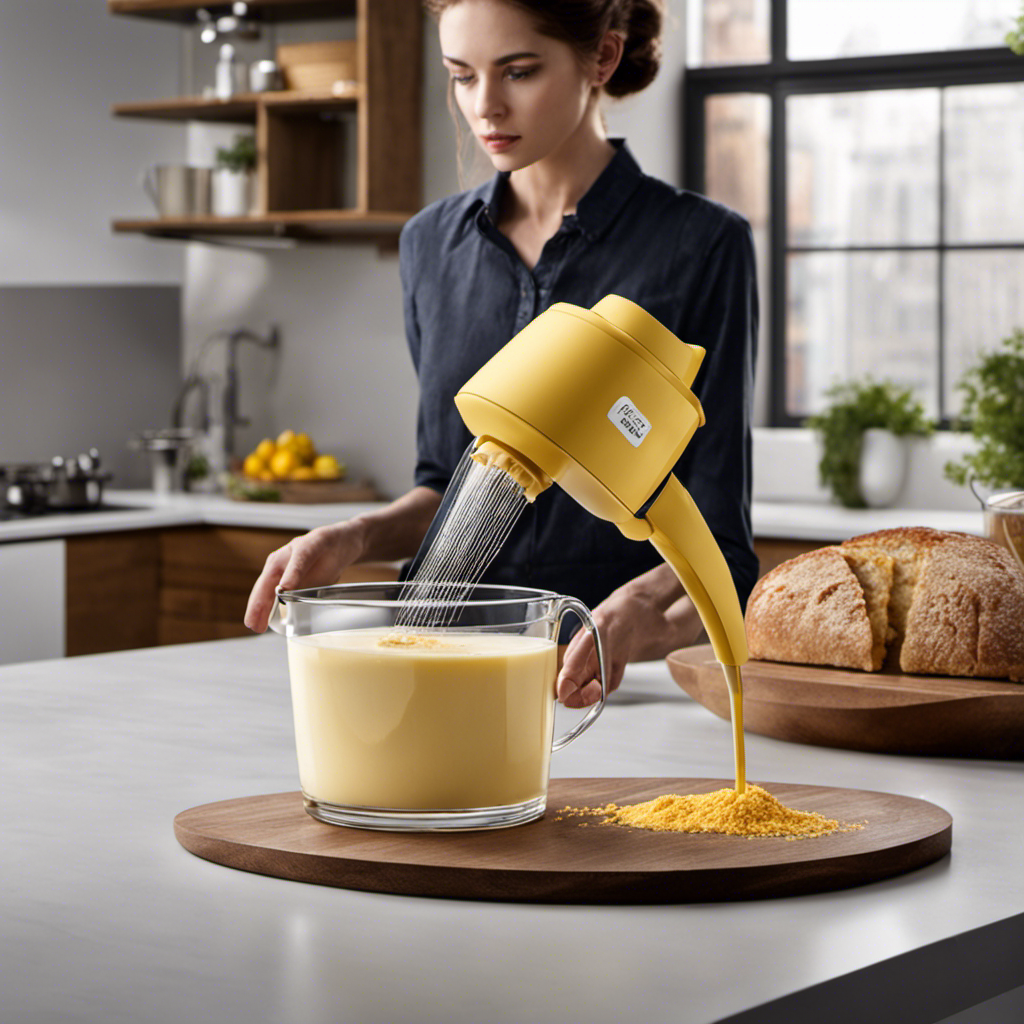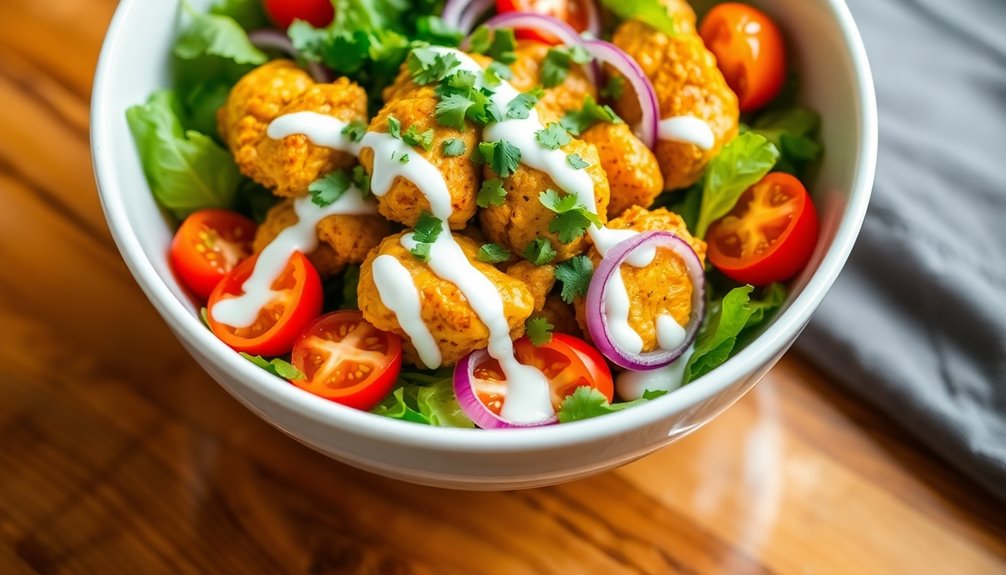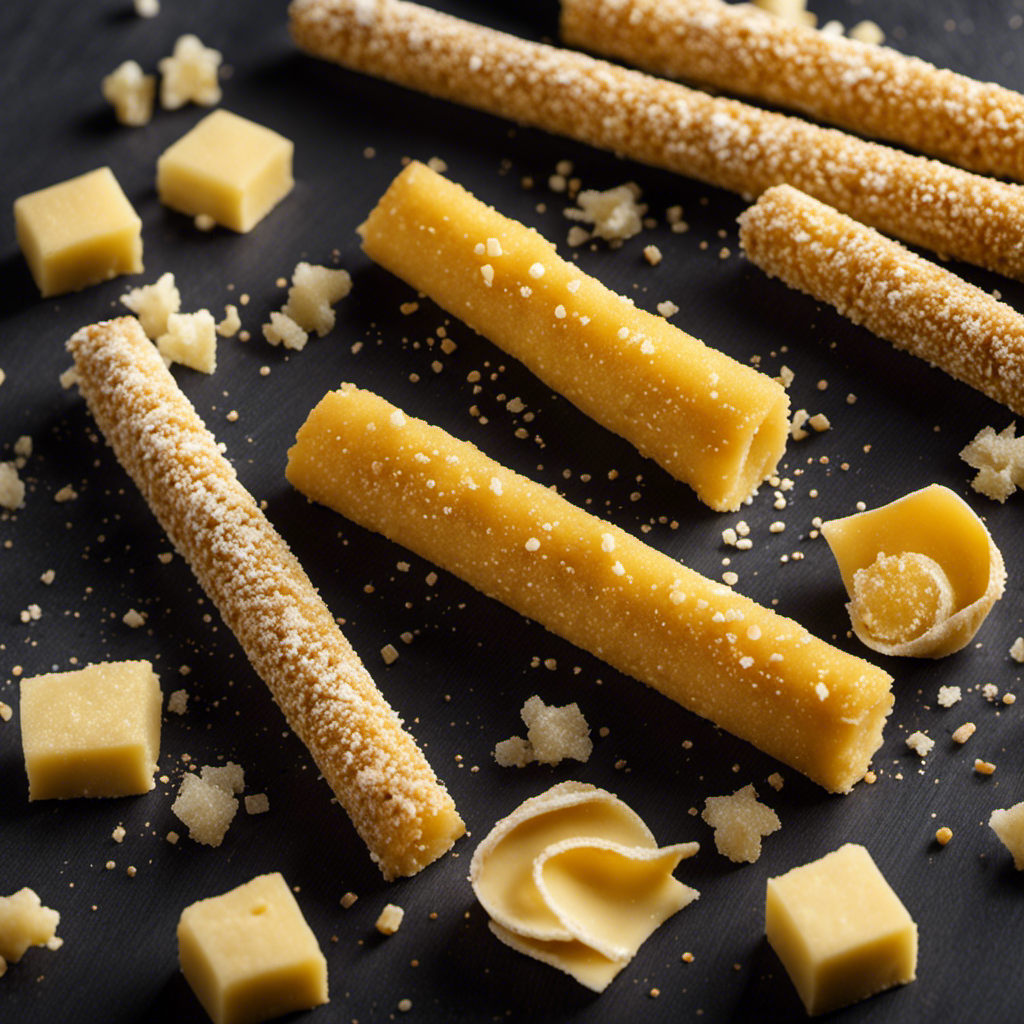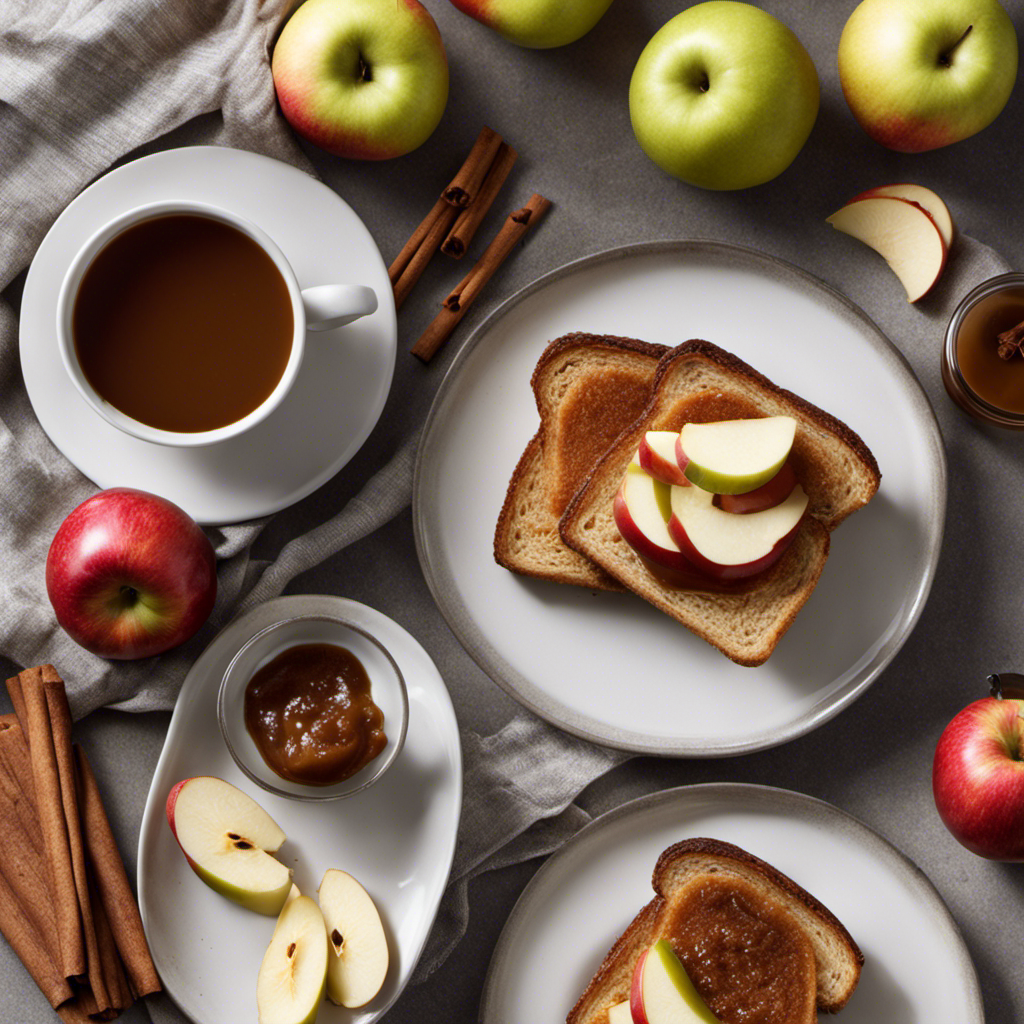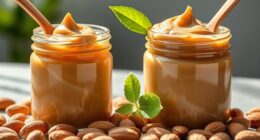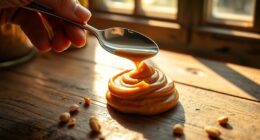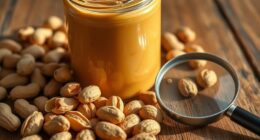I understand your skepticism – the idea of making butter from milk may seem like a complex task. However, I can guarantee you that it is a simple and fulfilling process.
In this article, I will guide you through the step-by-step process of how to make butter with milk. From gathering the ingredients to washing and shaping the butter, I will provide you with precise instructions to create your own homemade butter.
So put your doubts aside and let’s get started on this delicious journey.
Key Takeaways
- Fresh, full-fat milk is needed for better quality butter.
- Different churning methods have their own advantages and disadvantages.
- Various techniques can be used to separate the butter from the liquid.
- Proper storage of homemade butter ensures freshness and extends shelf life.
Step 1: Gathering the Ingredients
First, you’ll need to gather all of the necessary ingredients to make butter with milk. To begin, you’ll require fresh, full-fat milk. The higher the fat content, the better the quality of butter. Additionally, you’ll need a churning device, such as a butter churn or a stand mixer with a paddle attachment. This will help separate the butterfat from the liquid in the milk.
Next, gather a clean and dry container to collect the butter. It is essential to keep all utensils and equipment clean to avoid contamination. Lastly, make sure to have a pinch of salt on hand. While not necessary, salt enhances the flavor of the butter.
Now that you have gathered all the necessary ingredients and equipment, we can move on to step 2: preparing the milk.
Step 2: Preparing the Milk
Next, you’ll need to warm up the milk to the desired temperature. This step is crucial in order to achieve the right consistency and texture for your butter. The temperature at which you warm the milk will depend on the milk fat content you desire in your butter. Here’s a table to guide you:
| Milk Fat Content | Temperature (°F) |
|---|---|
| Low fat (1%) | 110-115 |
| Regular (2%) | 120-125 |
| Whole (3.25%) | 130-135 |
To warm up the milk, you can use a saucepan or a microwave. If using a saucepan, heat it over low heat and stir constantly until the milk reaches the desired temperature. If using a microwave, heat the milk in short intervals, stirring after each interval, to avoid overheating. Once the milk has reached the desired temperature, you’re ready to move on to the next step in making butter.
Step 3: Churning the Milk
When it comes to churning butter, there are various techniques that can be employed for optimal results. These techniques involve different methods of agitating the milk to separate the butterfat from the liquid.
Additionally, it is important to have the right equipment for milk churning, such as a churn or a hand mixer, to effectively carry out the process.
Churning Techniques for Butter
To achieve the perfect consistency for your butter, you’ll need to use a churning technique that incorporates air into the mixture. This will help to create a light and fluffy texture that is ideal for spreading on toast or baking.
There are several churning methods that you can try, and each has its own advantages and disadvantages.
-
Traditional Churning: This method involves using a manual churn or a jar with a tight-fitting lid. It requires physical effort and can be time-consuming, but it allows for better control over the churning process.
-
Electric Churning: With an electric butter churn, the process is more efficient and requires less effort. However, it may not provide the same level of control as traditional churning.
-
Blender Churning: Using a blender is a quick and easy way to churn butter. It is convenient, but it may not give you the same quality of butter as the other methods.
Troubleshooting common churning problems:
-
If the butter is not forming, the cream may not have enough fat content. Try using cream with a higher fat content.
-
If the butter is too soft, it may not have been churned long enough. Continue churning until the butter separates from the buttermilk.
-
If the butter is too hard, it may have been over-churned. Be careful not to churn for too long.
Equipment for Milk Churning
One option for churning milk into butter is using a butter churn, which provides better control over the churning process. However, there are alternatives to commercial butter churns that can be easily made at home.
DIY butter churns are simple devices that can be constructed using common household items. For example, a glass jar with a tight-fitting lid can be used as a makeshift butter churn. Simply pour the milk into the jar, secure the lid, and shake vigorously until the butter forms.
Another option is using a hand mixer or a stand mixer with a whisk attachment. These mixers can effectively churn the milk into butter within minutes.
These milk churning alternatives offer convenience and flexibility for those who prefer to make their own butter at home.
Step 4: Separating the Butter From the Liquid
After churning the milk for a few minutes, the butter will start to separate from the liquid. This separation occurs due to the difference in density between the butter fat and the remaining liquid. To achieve the best results, there are different methods for separating the butter from the liquid, depending on the desired butter fat content.
-
Traditional Method: Allow the churned milk to sit undisturbed for a while, allowing the butter to rise to the surface.
-
Centrifugal Method: Use a centrifugal separator to spin the churned milk at high speed, causing the butter to separate and collect in one chamber.
-
Skimmed Method: Carefully skim off the floating butter using a spoon or a spatula.
Step 5: Washing and Shaping the Butter
In this discussion, I will explore the shaping techniques for butter and the importance of washing butter.
Shaping techniques for butter involve molding it into desired shapes, such as sticks or cubes, using specialized tools or by hand.
Washing butter is crucial as it removes any excess buttermilk, which can lead to spoilage and affect the taste.
Shaping Techniques for Butter
To shape your butter, you can roll it into a log or press it into a mold. These shaping methods allow you to create beautiful and unique butter shapes that can enhance the presentation of your dishes.
Here are three popular shaping techniques to consider:
-
Rolling into a log: This method involves rolling the butter between your hands to create a cylindrical shape. It is a simple yet effective way to shape your butter, especially if you want to slice it easily for spreading on bread or toast.
-
Pressing into a mold: Using butter molds, you can press your butter into various shapes and designs. This technique is perfect for special occasions or when you want to impress your guests with intricately shaped butter.
-
Using cookie cutters: Another fun way to shape your butter is by using cookie cutters. Simply press the softened butter into the cookie cutter shape and carefully remove the excess. This technique allows you to create butter shapes that match the theme of your meal or event.
Experiment with these shaping methods and butter molds to add a touch of creativity and elegance to your homemade butter.
Importance of Washing Butter
Washing your butter is essential for removing any impurities and ensuring its freshness and quality. Proper storage of butter is important to maintain its taste and texture.
Homemade butter offers several benefits compared to store-bought options. When washing butter, it is crucial to use clean, cold water to rinse off any remaining buttermilk. This helps to remove any unwanted flavors and ensures a longer shelf life. Additionally, washing butter helps to improve its spreadability and enhances its overall taste.
Proper storage of butter involves keeping it in an airtight container in the refrigerator. This prevents it from absorbing odors and maintains its freshness.
Homemade butter is a healthier choice as it contains no additives or preservatives. It also allows you to control the quality of ingredients used, making it a satisfying and delicious option.
Tips for Butter Storage
After learning about the importance of washing butter, let’s now delve into the crucial topic of butter storage.
Proper storage techniques play a vital role in extending the shelf life of butter and maintaining its quality. Here are some essential tips to ensure your butter stays fresh and delicious:
-
Refrigeration: Store your butter in the refrigerator at a temperature between 32°F and 40°F (0°C and 4°C). This helps to slow down the growth of bacteria and prevents spoilage.
-
Air-tight Container: Place your butter in an air-tight container or wrap it tightly in foil or wax paper to protect it from absorbing odors and moisture from the surrounding environment.
-
Avoid Sunlight: Keep your butter away from direct sunlight, as exposure to light can cause it to become rancid and lose its flavor.
Step 6: Storing and Using Your Homemade Butter
Once you’ve made your homemade butter, it’s important to store it properly to maintain its freshness. To ensure the longevity of your homemade butter, here are some tips for storing and using it effectively:
| Storage Method | Temperature Range | Shelf Life |
|---|---|---|
| Refrigeration | 32°F – 40°F | 2-3 weeks |
| Freezing | 0°F or below | Up to 6 months |
| Canning | Sealed jar with proper processing | 9-12 months |
When storing homemade butter in the refrigerator, place it in an airtight container or wrap it tightly in wax paper to prevent it from absorbing other odors. If you decide to freeze your butter, divide it into smaller portions for easy thawing. Canning is another great option for long-term storage.
When using homemade butter, it is best to bring it to room temperature before use to achieve a smooth and spreadable consistency. Incorporate it into your favorite recipes or simply enjoy it on toast or baked goods. Remember, homemade butter adds a rich and creamy flavor to any dish, so make the most of it!
Frequently Asked Questions
How Long Does It Take to Make Butter With Milk?
It takes about 15 minutes to make butter with milk. The key to achieving a smooth texture is to use cold milk and a high-speed blender. Common mistakes include using warm milk and not blending long enough.
Can I Use Any Type of Milk to Make Butter?
Yes, any type of milk can be used to make butter. However, different types of milk may yield different results in terms of taste and texture. Experimentation is key.
Can I Skip the Churning Step and Still Make Butter?
Yes, you can skip the churning step and still make butter. An alternative to churning is to use a blender instead. This method allows for a quicker and more efficient way of separating the cream from the milk to make butter.
Is It Necessary to Wash the Butter After Separating It From the Liquid?
Washing the butter after separating it from the liquid is necessary. It affects the taste by removing any residual buttermilk, resulting in a purer flavor.
How Long Can Homemade Butter Be Stored Before It Goes Bad?
Homemade butter can be stored for up to two weeks before it goes bad. To maximize shelf life, it is important to use proper storage methods such as keeping it refrigerated in an airtight container.
Conclusion
In conclusion, making butter with milk is a simple and satisfying process. By gathering the necessary ingredients and following the precise steps of preparing, churning, separating, washing, and shaping, you can create your own creamy and delicious homemade butter.
Remember to store it properly to maintain its freshness and enjoy it in various culinary creations. So, seize the opportunity to savor the satisfaction of successfully crafting your own butter, bringing a burst of buttery brilliance to your kitchen!
